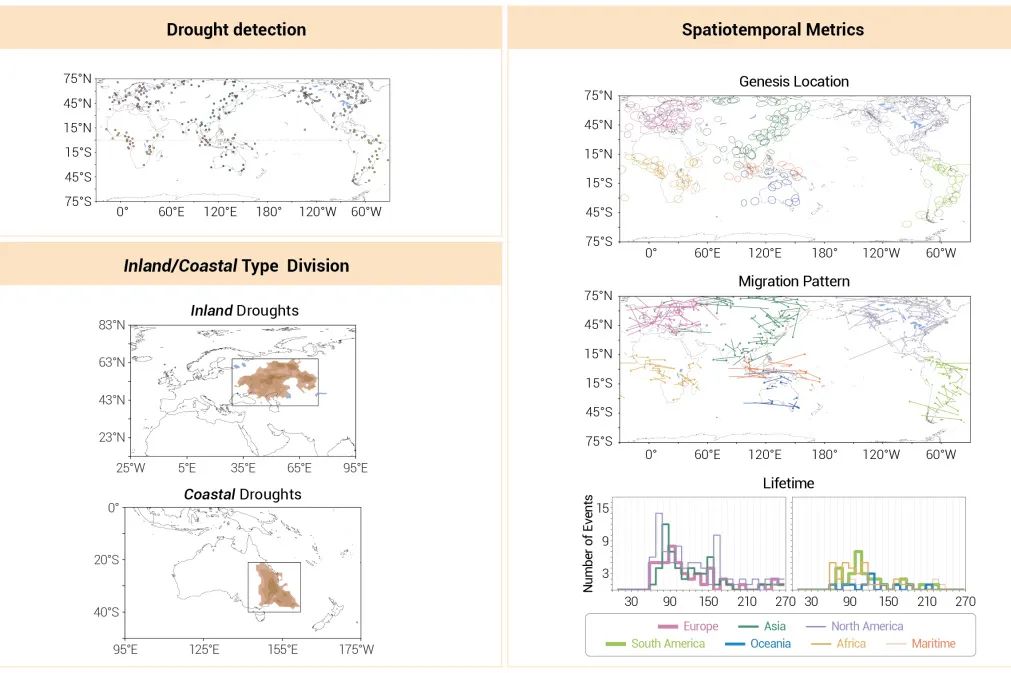
导读

图1 图文摘要
近年来,全球范围内严重气象干旱事件频发,由此引发的供水危机、生态毁坏、粮食减产以及社会冲突等系列次生问题,带来严重社会经济影响。作为抗旱减灾的重要环节,精准识别这些气象干旱事件,研究它们的时空变化特征并进行类型划分,具有重要的理论意义与社会价值。近日,Science合作期刊Ocean-Land-Atmosphere Research (OLAR)发表了题为“Global seasonal-scale meteorological droughts. Part I: detection, metrics, and inland/coastal types”的研究论文,对上述问题展开了深入研究。
研究成果
本研究以反映持续性降水亏缺的季节尺度气象干旱事件为研究对象,主要研究成果如下:
Part 01.
全球事件集获取。全球范围内的极端气象干旱事件,往往具有复杂的时空变化特征,它们可以发展、消亡于不同季节,强度大小和历时长短不一,空间运动形式(局地生消/演进传播)不尽相同。为此,本研究借助3D DBSCAN(Three-Dimensional Density-Based Spatial Clustering of Applications with Noise)算法,设计了极端气象干旱事件识别框架,通过“三维重旱格点的点簇聚类”—“考虑长历时和大范围特征的点簇筛选”—“点簇周围中等强度格点的再融合”这三步,实现对1980–2020年全球气象干旱事件的提取。
Part 02.
“内陆/沿海”类型划分。针对上述获取的干旱事件,依据受旱格点的海陆落区,以及相应的陆地面积占比及累积时间,将干旱事件进一步划分为内陆型(Inland)以及沿海型(Coastal)。如图2所示,2010年欧洲夏秋大旱为内陆型,而2011年长江中下游春夏大旱、2014年南美洲巴西夏旱均为沿海型。“内陆/沿海”类型划分的必要性在于其影响机理可能不同。例如,2010年欧洲大旱的持续发展受到陆气耦合作用的调制,而2014年南美洲巴西夏旱发生则与临近海域的海洋热浪事件密切相关。

图2 全球典型极端气象干旱事件的时空演变(A–D为沿海型;E–G为内陆型)。左三列为干旱事件在发生、极值、结束时刻的受旱格点空间分布;第四列为受旱面积演变(粗线为陆地和洋面上空所有受旱格点,细线仅为陆地受旱格点);第五列为最大传播距离及相应轨迹。
Part 03.
时空特征测度与空间传播特性。针对上述不同类型的干旱事件,可进一步进行时空特征分析和空间传播特性研究。在本研究中,除了度量前人常用的“干旱总历时”、“最大传播距离”、“质心轨迹”等特征,作者还设计了“干旱早期信号的落区类型(Genesis Location)”(见图3C和D)、“局地覆盖率(Local Coverage Ratio,LCR)”(见图4E和F)等指标。前者用来研究干旱事件的早期信号落区,为干旱早期预警提供可能;后者用于定量刻画空间传播特征,为后续机理探索提供分析基础。

图3 全球沿海型/内陆型气象干旱事件的度量指标的空间分布。A和B为干旱质心位置,C和D为干旱早期信号的空间落区;E和F为最大传播距离;G和H为全球受旱格点的遍历次数。

图4 全球各洲沿海型/内陆型气象干旱事件的时空统计特征。A和B为干旱总历时,C和D为空间传播方位角;E和F为空间传播特性,通过局地覆盖比率(Local Coverage Ratio,LCR)和最大传播距离(Max. Displacement Distance)进行定量描述。
总结与展望
本研究借助3D DBSCAN算法框架,在全球范围内识别“高强度、长历时、大范围”的极端气象干旱事件,进行沿海/内地的类型划分,并进行空间演进特征、早期干旱信号落区等属性的测度分析。研究成果可为后续机理分析提供大量精确样本及三维时空测度信息。
原文链接:https://spj.science.org/doi/10.34133/olar.0016
文章标题:
Global Seasonal-Scale Meteorological Droughts. Part I: Detection, Metrics, and Inland/Coastal Types
文章作者:
Zhenchen Liu and Wen Zhou
文章摘要:
Knowledge of spatiotemporal characteristics and process evolutions is the fundamental basis of understanding drought mechanisms, especially from a global perspective. For a comprehensive investigation, we implemented event detection, type grouping, and spatiotemporal metrics from 3-dimensional (3D, longitude–latitude–time) perspectives. The major procedures and achievements were as follows. First, we identified global-scale seasonal-scale meteorological drought events following the recently proposed 3D DBSCAN (Density-Based Spatial Clustering of Applications with Noise)-based workflow of event detection. The 3D DBSCAN clustering algorithm can directly obtain arbitrarily shaped point collections over a given 3D space, as drought events can spread over space and evolve over time. Subsequently, these detected drought events are further grouped into inland and coastal types, as the observations revealed that some droughts over coastal regions originate from, extend to, or are accompanied by long-term precipitation deficits over adjacent oceans. Third, typical spatiotemporal characteristics (e.g., lifetime, genesis locations, migration/local developments, and process evolutions) were investigated with coastal/inland-type differences considered. The drought ratios originating from continents in all coastal-type droughts were ~50% over Africa, Asia, and South America, indicating the nonnegligible extension from continents to oceans. Additionally, process evolution-based analysis revealed intensity variations in intensification or recession phases, and coastal types overall displayed larger intensity variations than inland types. Moreover, ~92% of inland types and ~70% of coastal types can be treated as having symmetric development. Notably, the grouping type and spatiotemporal metrics herein can provide adequate preliminary knowledge for global-scale drought mechanism exploration.
文章引用:
Liu Z, Zhou W. Global Seasonal-Scale Meteorological Droughts. Part I: Detection, Metrics, and Inland/Coastal Types. Ocean-Land-Atmos. Res. 2023;2:Article 0016.
https://doi.org/10.34133/olar.0016


OLAR 期刊简介
Ocean-Land-Atmosphere Research (OLAR) 由南方海洋实验室和美国科学促进会合作出版,入选2022年度中国科技期刊卓越行动计划高起点新刊项目,是海洋负排放国际大科学计划(Ocean Negative Carbon Emissions, ONCE)指定的官方唯一合作期刊。期刊以“服务科学研究,推动技术创新”为办刊宗旨,坚持发表高质量、高水平论文,力争成为具有较大影响力的国际一流学术期刊。本刊以海洋相关学科为重点,刊稿主题包括但不限于:海陆气相互作用、海洋碳中和、物理海洋学、海洋生物与生态、海洋地质与地球物理、化学海洋学、海洋气象学、大气物理与大气环境、冰冻圈科学、河口海岸学、海洋工程与海洋技术、海洋资源开发与利用。OLAR 投稿系统目前已正式开放,热烈欢迎相关研究领域科学家踊跃投稿。分享卓见,探索前沿,OLAR 诚邀您一起荟萃科学发现,共享学术盛筵!
期刊官网:https://spj.science.org/journals/olar/
投稿系统:https://www.editorialmanager.com/olar/

扫码关注OLAR官方微信公众号


